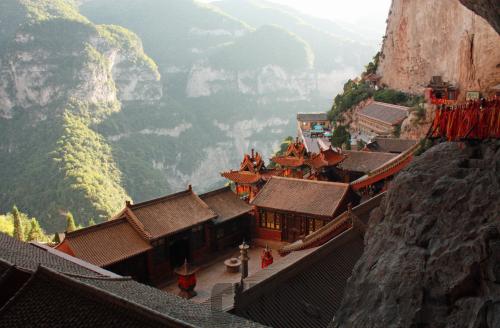| 
If you ask Chinese people and local expats about the greatest destinations in north China's Shanxi Province, most of them will probably mention the majestic Yungang Grottoes near Datong, the ancient city of Pingyao and the sacred mountain of Wutaishan. I had the pleasure of visiting all three beautiful places during my stay in China, first as an exchange student and then as a young professional living and working in Beijing. Recently, my work brought me to a lesser-known but equally stunning area in Shanxi Province: Mianshan.
Located 40 km south of Pingyao and at about 2,000 meters above sea level, Mianshan is a national 5A-level tourism spot and the birthplace of a major Chinese traditional festival: Qingming Festival, or Tomb Sweeping Day.
Steeped in legend and ancient history, these sheer cliffs were also called the Jieshan Mountain after Jie Zitui, whose story can be traced back to the Spring and Autumn Period around 2,650 years ago. At that time, Jie was prime minister of the Jin Kingdom. He followed his exiled king throughout hardships, but refused to be rewarded after the king was restored the throne. As Jie retreated to Mianshan, the king ordered the entire mountain to be set on fire so as to force him out of hiding. Unfortunately, Jie was later found dead. To honor his memory, the king declared the day of his death Hanshijie, or Cold Food Day, on which people should make no fires and eat only cold dishes. During the Qing Dynasty (1644-1911), this tradition was replaced by a new one marked by the visiting of family graves, and thus was born Qingming Festival.
As a Chinese culture enthusiast, I was thrilled to discover this story through the Mianshan Museum and memorial spots such as the Jiegong Temple. But Mianshan has even more to offer, starting with its amazing natural scenery and some very specific relics reflecting Buddhist and Taoist cultural traditions.
After his death, when Jie became a god, which local people like to believe, many devotees made the trek to Mianshan to visit his tomb, including many religious masters. During their stay, some Taoist and Buddhist monks began building temples on top of the cliffs - vantage points that offer spectacular views over the valley. Unfortunately, many of the original constructions were destroyed by Japanese troops during the Second World War; most of the monuments standing in Mianshan today are restored versions of the originals. Some sites are even equipped with a high-speed elevator that can take visitors to the highest spot on the cliff in less than a minute. Aside from the modern renovations, many must-see places still represent the original cultural heritage of the temples at Mianshan.
The Yunfeng Temple is definitely one of them. Located in the largest natural rock cave in Mianshan, most of it was protected from Japanese bombing in 1940. Its simplicity and authenticity give the temple a particular charm. Consisting of more than 200 halls and rooms, it provides a peaceful and quiet environment for those wanting a relaxing time in the mountains. For those keener on spectacular views and Taoist culture, the seven-level pagoda of the Zhengguo Temple is definitely the place to go.
Thanks to my visit to Mianshan, I also discovered an ancient religious practice that I had never before encountered during my studies and time in China: the tradition of building mummy statues over real Taoist or Buddhist monks who died in meditation. It was interesting to be able to take a close look at some of them, as they are quite well preserved.
In my opinion, Mianshan is a must-see destination for all Chinese culture and history lovers, especially Chinese speakers. This area has a lot to offer to the general public, whether it is the huangjiu - a traditional yellow millet wine usually served warm - or its waterfalls in wilder parts of the mountain. |